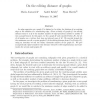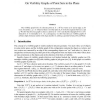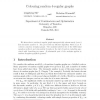316 search results - page 27 / 64 » The chromatic covering number of a graph |
JGT
2008
13 years 8 months ago
2008
An edge-operation on a graph G is defined to be either the deletion of an existing edge or the addition of a nonexisting edge. Given a family of graphs G, the editing distance fro...
COMBINATORICS
2000
13 years 8 months ago
2000
A mixed hypergraph is a triple H = (V, C, D) where V is the vertex set and C and D are families of subsets of V , the C-edges and D-edges, respectively. A k-colouring of H is a ma...
COMBINATORICS
2006
13 years 8 months ago
2006
A biclique is a complete bipartite subgraph of a graph. This paper investigates the fractional biclique cover number, bc(G), and the fractional biclique partition number, bp(G), o...
DCG
2008
13 years 8 months ago
2008
The visibility graph V(X) of a discrete point set X R2 has vertex set X and an edge xy for every two points x, y X whenever there is no other point in X on the line segment betw...
CPC
2007
13 years 8 months ago
2007
We show that a random 4-regular graph asymptotically almost surely (a.a.s.) has chromatic number 3. The proof uses an efficient algorithm which a.a.s. 3colours a random 4-regular ...



